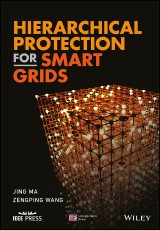Details

Hierarchical Protection for Smart Grids
1. Aufl.
|
123,99 € |
|
| Verlag: | Wiley |
| Format: | |
| Veröffentl.: | 28.03.2018 |
| ISBN/EAN: | 9781119304838 |
| Sprache: | englisch |
| Anzahl Seiten: | 472 |
DRM-geschütztes eBook, Sie benötigen z.B. Adobe Digital Editions und eine Adobe ID zum Lesen.
Beschreibungen
<p><i><b>A systematic view of hierarchical protection for smart grids, with solutions to tradition protection problems and complicated operation modes of modern power systems</b></i></p> <p>• Systematically investigates traditional protection problems from the bird’s eye view of hierarchical protection</p> <p>• Focuses on multiple variable network structures and complicated operation modes</p> <p>• Offers comprehensive countermeasures on improving protection performance based on up-to-date research</p>
<p>About the Author ix</p> <p>Foreword xi</p> <p>Preface xiii</p> <p>Introduction xv</p> <p><b>1 Basic Theories of Power System Relay Protection 1</b></p> <p>1.1 Introduction 1</p> <p>1.2 Function of Relay Protection 1</p> <p>1.3 Basic Requirements of Relay Protection 3</p> <p>1.3.1 Reliability 3</p> <p>1.3.2 Selectivity 4</p> <p>1.3.3 Speed 4</p> <p>1.3.4 Sensitivity 5</p> <p>1.4 Basic Principles of Relay Protection 6</p> <p>1.4.1 Over-Current Protection 6</p> <p>1.4.2 Directional Current Protection 6</p> <p>1.4.3 Distance Protection 7</p> <p>1.5 Hierarchical Relay Protection 9</p> <p>1.5.1 Local Area Protection 10</p> <p>1.5.2 Substation Area Protection 11</p> <p>1.5.3 Wide Area Protection 12</p> <p>1.5.4 Constitution Mode of Hierarchical Relay Protection 13</p> <p>1.6 Summary 15</p> <p>References 15</p> <p><b>2 Local Area Conventional Protection 17</b></p> <p>2.1 Introduction 17</p> <p>2.2 Transformer Protection 18</p> <p>2.2.1 Adaptive Scheme of Discrimination between Internal Faults and Inrush Currents of Transformer Using Mathematical Morphology 18</p> <p>2.2.2 Algorithm to Discriminate Internal Fault Current and Inrush Current Utilizing Variation Feature of Fundamental Current Amplitude 30</p> <p>2.2.3 Identifying Transformer Inrush Current Based on Normalized Grille Curve (NGC) 39</p> <p>2.2.4 Adaptive Method to Identify CT Saturation Using Grille Fractal 50</p> <p>2.2.5 Algorithm for Discrimination Between Inrush Currents and Internal Faults Based on Equivalent Instantaneous Leakage Inductance 57</p> <p>2.2.6 A Two-Terminal Network-Based Method for Discrimination between Internal Faults and Inrush Currents 70</p> <p>2.3 Transmission Line Protection 82</p> <p>2.3.1 Line Protection Scheme for Single-Phase-to-Ground Faults Based on Voltage Phase Comparison 83</p> <p>2.3.2 Adaptive Distance Protection Scheme Based on the Voltage Drop Equation 99</p> <p>2.3.3 Location Method for Inter-Line and Grounded Faults of Double-Circuit Transmission Lines Based on Distributed Parameters 117</p> <p>2.3.4 Adaptive Overload Identification Method Based on Complex Phasor Plane 134</p> <p>2.3.5 Novel Fault Phase Selection Scheme Utilizing Fault Phase Selection Factors 148</p> <p>2.4 Summary 172</p> <p>References 172</p> <p><b>3 Local Area Protection for Renewable Energy 175</b></p> <p>3.1 Introduction 175</p> <p>3.2 Fault Transient Characteristics of Renewable Energy Sources 176</p> <p>3.2.1 Mathematical Model and LVRT Characteristics of DFIG 177</p> <p>3.2.2 DFIG Fault Transient Characteristics When the Crowbar Protection Is Not Put into Operation 178</p> <p>3.2.3 DFIG Fault Transient Characteristics When the Crowbar Protection Is Put into Operation 211</p> <p>3.3 Local Area Protection for Centralized Renewable Energy 230</p> <p>3.3.1 Connection Form of a Wind Farm and its Protection Configuration 231</p> <p>3.3.2 Adaptive Distance Protection Scheme for Wind Farm Collector Lines 233</p> <p>3.3.3 Differential Protection Scheme for Wind Farm Outgoing Transmission Line 239</p> <p>3.4 Local Area Protection for Distributed Renewable Energy 248</p> <p>3.4.1 Adaptive Protection Approach for Distribution Network Containing Distributed Generation 248</p> <p>3.4.2 Islanding Detection Method 255</p> <p>3.5 Summary 269</p> <p>References 270</p> <p><b>4 Topology Analysis 273</b></p> <p>4.1 Introduction 273</p> <p>4.2 Topology Analysis for Inner Substation 273</p> <p>4.2.1 Characteristic Analysis of the Main Electrical Connection 274</p> <p>4.2.2 Topology Analysis Method Based on Main Electrical Wiring Characteristics 275</p> <p>4.2.3 Scheme Verification 278</p> <p>4.3 Topology Analysis for Inter-substation 284</p> <p>4.3.1 Static Topology Analysis for Power Network 285</p> <p>4.3.2 Topology Update for Power Network 287</p> <p>4.3.3 Scheme Verification 291</p> <p>4.4 False Topology Identification 294</p> <p>4.4.1 Road-Loop Equation 294</p> <p>4.4.2 Analysis of the Impacts of Topology Error and Undesirable Data on Branch Current 296</p> <p>4.4.3 Topology Error Identification Method Based on Road-loop Equation 300</p> <p>4.4.4 Scheme Verification 301</p> <p>4.5 Summary 315</p> <p>References 316</p> <p><b>5 Substation Area Protection 317</b></p> <p>5.1 Introduction 317</p> <p>5.2 Substation Area Protection Based on Electrical Information 317</p> <p>5.2.1 Substation Area Regionalization 318</p> <p>5.2.2 Typical Fault Cases 323</p> <p>5.2.3 Scheme Performance Analysis 326</p> <p>5.3 Substation Area Protection Based on Operating Signals 327</p> <p>5.3.1 Setting Principle of Adaptive Current Protection 327</p> <p>5.3.2 Supporting Degree Calculation Method 330</p> <p>5.3.3 Substation Area Current Protection Algorithm 334</p> <p>5.3.4 Scheme Verification 338</p> <p>5.4 Summary 346</p> <p>References 346</p> <p><b>6 Wide Area Protection 347</b></p> <p>6.1 Introduction 347</p> <p>6.2 Wide Area Protection Using Electrical Information 347</p> <p>6.2.1 Wide-Area Protection Using Fault Power Source Information 348</p> <p>6.2.2 Wide-Area Protection Using Fault Network Information 358</p> <p>6.2.3 Wide-Area Protection Suitable for Multiple Fault Identification 369</p> <p>6.3 Wide Area Protection Using Operating Signals 375</p> <p>6.3.1 Wide-Area Protection Based on Distance Protection Operational Signal 376</p> <p>6.3.2 Wide-Area Protection Based on Current Protection Operational Signal 393</p> <p>6.3.3 Wide-Area Protection Based on Virtual Impedance of Fault Component 406</p> <p>6.4 Wide Area Tripping Strategy 419</p> <p>6.4.1 Tripping Strategy Based on Directional Weighting 419</p> <p>6.4.2 Simulation Verification 428</p> <p>6.5 Summary 432</p> <p>References 433</p> <p>Appendices 435</p> <p>Index 439</p>
<p><b>Zengping Wang and Jing Ma</b>, North China Electric Power University, Beijing, China</p>

















